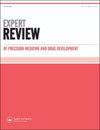Ramucirumab or merestinib in biliary tract cancer: new combinations, old mistakes?
IF 1.2
Q4 PHARMACOLOGY & PHARMACY
Expert Review of Precision Medicine and Drug Development
Pub Date : 2022-01-02
DOI:10.1080/23808993.2022.2095903
引用次数: 0
Abstract
Biliary tract cancers (BTCs) encompass a heterogeneous group of rare malignancies accounting for approximately the 10–15% of primary liver cancers [1]. Most of these hepatobiliary tumors are diagnosed at a metastatic stage, and more than a decade after the publication of the ABC-02 trial establishing gemcitabine plus cisplatin as front-line standard for metastatic BTC, the prognosis of this patient population remains grim [2]. BTC include intrahepatic cholangiocarcinoma (iCCA), extrahepatic cholangiocarcinoma (eCCA), and gallbladder carcinoma (GBC); recent years have registered that the incidence of BTC has progressively increased worldwide, and a proportion of cases ranging from 60% to 70% is diagnosed with advanced stage – locally advanced or metastatic disease. Surgical resection represents the only potentially curative treatment option for BTC patients, but even following radical surgery with curative intent, 5-year overall survival (OS) is only 20–35%. Systemic treatment options for BTC are limited, and more than a decade after the practice-changing ABC-02 phase III trial, cisplatin-gemcitabine remains the standard first-line therapy for patients with metastatic disease. Recent years have witnessed the advent of molecular profiling in this setting, and new techniques and technologies have led to the identification of several molecular alterations in BTC [3]. Thus, precision oncology approaches have been widely evaluated and are currently under assessment in BTC patients, as shown by the recent development of a wide range of agents targeting Fibroblast Growth Factor Receptor (FGFR) 2, Isocitrate Dehydrogenase 1 (IDH-1), and BRAF [4–6]. However, a number of molecularly targeted therapies, including antiangiogenic agents, have shown limited efficacy in BTC, and several questions regarding the effective role of these anticancer treatments remain unanswered. A recently published phase 2 trial has evaluated the addition of ramucirumab or merestinib to first-line cisplatin-gemcitabine, reporting no improvement of progression-free survival (PFS) in patients with locally advanced or metastatic BTC [7]. Ramucirumab is a fully humanized monoclonal antibody with a high binding affinity for the extracellular domain of VEGFR-2, with preclinical studies showing that targeting of this VEGF family receptor was associated with inhibition of VEGF-mediated signaling, proliferation and migration of human endothelial cells, and antitumor activity in animal models. Conversely, merestinib is a small molecule inhibitor of MET and several other receptor tyrosine kinases such as MST1R, FLT3, AXL, MERTK, TEK, ROS1, NTRK1/2/3, and DDR1/2. Aiming to interpret the results of the study conducted by Valle and colleagues, some comments come to mind. First, the rationale for this international, double-blind, phase 2 study regarding antiangiogenic agents was probably based on the limited availability of treatments in advanced BTC at the time this trial was designed. Several studies have recently evaluated biological therapies targeting angiogenesis (such as bevacizumab, vandetanib, and sorafenib), highlighting no conclusive evidence of the higher efficacy of these agents in this setting [8]. Second, the interplay between BTC cells and host immunological microenvironment is not well known, and a better understanding of the mechanisms of angiogenesis remains an unmet need in BTC, together with the identification of predictors of response to biological therapies. Despite notable attempts have been made over time to improve the efficacy of front-line treatment, the optimization of first-line chemotherapy in BTC remains challenging, and several trials are – still – based on the addition of a third drug to the reference doublet, a strategy that has already shown important limitations in drug development for BTC [9]. In addition, the inclusion of different anatomical subgroups (intrahepatic cholangiocarcinoma, extrahepatic cholangiocarcinoma, gallbladder cancer) under the broad category of BTC remains a long-standing issue in clinical trial design, and stratification of BTC patients according to subgroups should always be considered in studies on these tumors, since different subgroups mirror distinct prognosis and clinical outcomes. The fact that BTCs are both rare forms of cancer and highly heterogeneous partially explains why patient survival has not improved significantly over the last decade – or rather, less than we would have hoped. Although we are witnessing a new era in BTC management, more than 10 years after the publication of the landmark ABC-02 trial, the combination of cisplatin plus gemcitabine in the first-line setting remains the standard treatment for patients without targetable alterations. The development of novel molecules and the identification of additional therapeutic targets represent urgent needs, and results of ongoing clinical trials are awaited, with the hope of providing better clinical outcomes in advanced BTC patients [10].胆道肿瘤的Ramucirumab或merestinib:新的组合,旧的错误?
新分子的开发和额外治疗靶点的鉴定是迫切需要的,正在进行的临床试验的结果正在等待中,希望能为晚期BTC患者提供更好的临床结果[10]。
本文章由计算机程序翻译,如有差异,请以英文原文为准。
求助全文
约1分钟内获得全文
求助全文
来源期刊

Expert Review of Precision Medicine and Drug Development
PHARMACOLOGY & PHARMACY-
CiteScore
2.30
自引率
0.00%
发文量
9
期刊介绍:
Expert Review of Precision Medicine and Drug Development publishes primarily review articles covering the development and clinical application of medicine to be used in a personalized therapy setting; in addition, the journal also publishes original research and commentary-style articles. In an era where medicine is recognizing that a one-size-fits-all approach is not always appropriate, it has become necessary to identify patients responsive to treatments and treat patient populations using a tailored approach. Areas covered include: Development and application of drugs targeted to specific genotypes and populations, as well as advanced diagnostic technologies and significant biomarkers that aid in this. Clinical trials and case studies within personalized therapy and drug development. Screening, prediction and prevention of disease, prediction of adverse events, treatment monitoring, effects of metabolomics and microbiomics on treatment. Secondary population research, genome-wide association studies, disease–gene association studies, personal genome technologies. Ethical and cost–benefit issues, the impact to healthcare and business infrastructure, and regulatory issues.
 求助内容:
求助内容: 应助结果提醒方式:
应助结果提醒方式:


